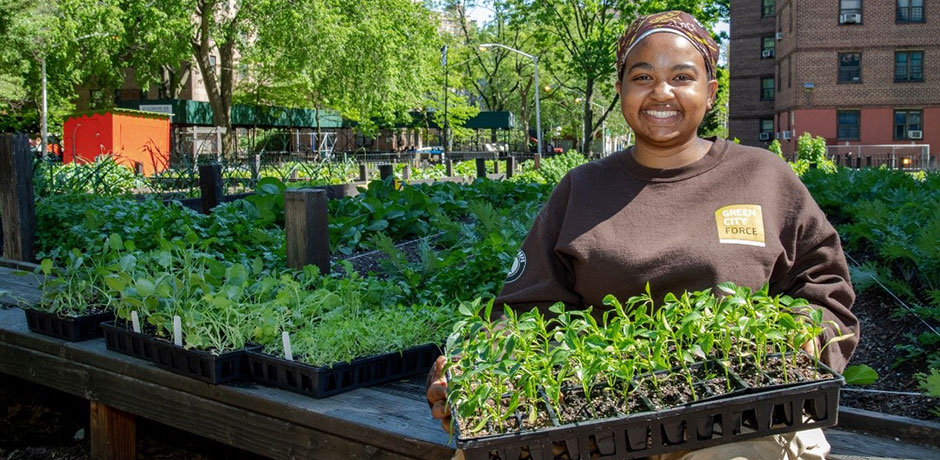The Ultimate Guide To City Blooming
Table of ContentsAll about City BloomingWhat Does City Blooming Mean?The Ultimate Guide To City BloomingThe 9-Minute Rule for City BloomingThe Definitive Guide for City Blooming
Intrigued in growing food for sale in the City of Chicago? Below is a checklist of regularly asked concerns concerning the policies and laws that growers ought to think about when intending a metropolitan farming project.
The zoning modification does not change any kind of other codes taking care of composting, building licenses, acquiring or renting City had residential property, service licenses or ecological contamination. There are existing codes that regulate these issues and they stay completely effect and might be suitable to your task. Area yards are commonly owned or handled by public entities, public organizations or community-based companies and preserved by volunteers.
Urban farms expand food that is planned to be marketed, either on a not-for-profit or for-profit basis. Because of their business objective, city farms require an organization certificate. Yes. A community garden is enabled to sell surplus generate that was grown on website if the sales are accessory or secondary to the garden's main objective defined above.
The Ultimate Guide To City Blooming
The quantity of garden compost product can not surpass 25 cubic yards at any kind of provided time according to the standards in 7-28-715 of the City's Municipal Code. Due to the fact that the soil at many new yard sites needs changing, compost, dirt, timber chips, or various other materials can be gotten to build or enhance the expanding space.

If a building permit is called for after that the hoophouse will certainly be taken into consideration an accessory structure. You can learn even more about the building authorization needs by getting in touch with the Division of Buildings. The 25,000-square-foot size limit is planned to stop a single neighborhood garden from dominating a provided block or detracting from the block's existing domestic or business character.
The restriction does not use to gardens located in Public Open Area (POS) districts. Can there be even more than one area garden that is 25,000 square feet on a single block? Secure fencing is not needed, nevertheless, yards that have big parking areas might be called for to set up secure fencing or other landscape design attributes.
City Blooming for Beginners
B1 & B2 districts call for that all business use activities be carried out inside your home. Is fence needed for metropolitan farms? Fences may be required, along with landscape design and screening, for specific auto parking areas and outdoor job or storage space areas depending on location and the particular task taking location.
Urban farms require structure permits and zoning approvals prior to building (urban gardening). Other forms of city testimonial might be called for depending on certain frameworks, tasks, dimension, landscape design, licensing, public heath and stormwater administration problems.
The Department of Company Matters and Customer Protection can assist identify the details type of organization license that's called for. Off road vehicle parking is required for many business projects in Chicago. The needed number of auto parking spaces is based on the number of staff members functioning on website and not the square video footage of the growing area.
An Unbiased View of City Blooming

Yes. A city ranch can offer compost product generated on site, however, the operation must conform with the laws in 7-28-715 of the Chicago Municipal Code. Yes. Aquaponic systems are enabled inside on city farms in numerous zoning districts. Nonetheless, a zoning review and building permit is needed in order to mount frameworks or systems and a business license is needed as described above.
As much as five hives or nests of honey bees might be kept as an accessory usage. Beekeepers need to register with the Illinois Department of Farming. For additional information about the recommended zoning modification you might get in touch with the Division of Housing and Economic Development, Bureau of Preparation and Zoning at 312.744.8563.
Farming in cities and metropolitan areas An urban ranch in Chicago. Urban agriculture refers to numerous techniques of growing. https://www.easel.ly/browserEasel/14490178, processing, and dispersing food in city areas. The term additionally applies to the location tasks of animal husbandry, tank farming, beekeeping, and gardening in a metropolitan context. Urban agriculture is differentiated from peri-urban farming, which occurs in rural areas at the edge of residential areas.
Little Known Facts About City Blooming.
, who look for to develop social networks established special info on a common ethos of nature and community holism. These networks can create by means of official institutional support, coming to be integrated into regional community planning as a "transition town" movement for sustainable urban growth.
Some of the first proof of urban farming comes from Mesopotamia.